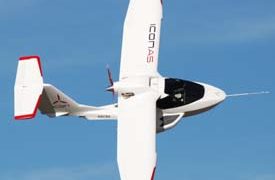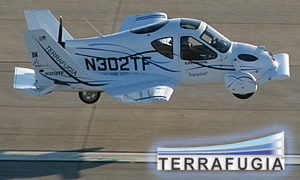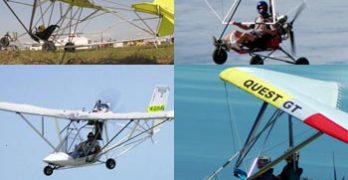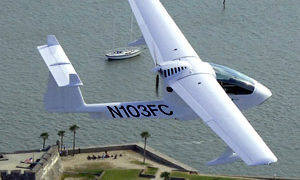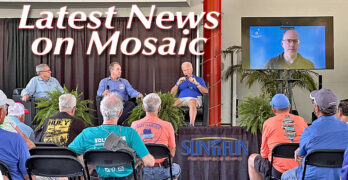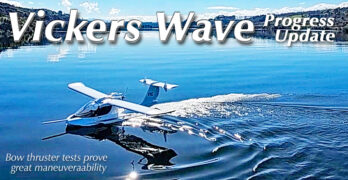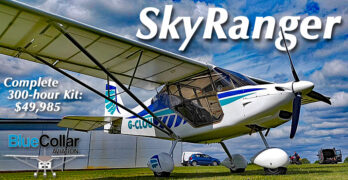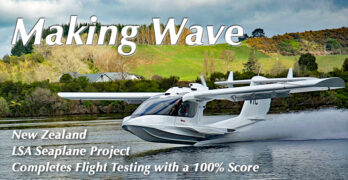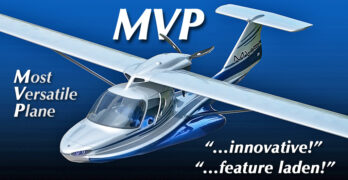Important FAA-related message at end of this article.
Opening day at AirVenture Oshkosh 2013 and the very first announcement before exhibit spaces even opened was a press conference from Icon Aircraft. To a media-only group of perhaps 30 or 40 media personalities, CEO Kirk Hawkins began, “Is there anyone here who doesn’t know what this about?” No one responded; everyone knew what the rumor mill had begun spewing. Icon is in good company. Even premiere new product secret-keeper, Apple Inc., has trouble announcing something that no one expected. Yet a few comments from the top gun at Icon were of special interest. One other observation first: it was a media event, but if even a single FAA person was in attendance, they were under cover. No FAA shirts or badges could be spotted. Thus Icon made their announcement without any active FAA participation.
Icon received Grant of Exemption No. 10829 for a weight increase with FAA stating,”The combined features and SRA (Spin Resistant Airframe) incorporated into the Icon A5 design … are recognized by the FAA as significant safety enhancements.” FAA also referenced that the agency felt an exemption was “in the public’s interest.” Kirk Hawkins added that his engineers “put safety ahead of arbitrary weight limits” and forged ahead with enhancements to include a more crashworthy cockpit, the airframe parachute (about which they’d already talked but with which the weight increase became more possible), and of course, the wing cuffs, “a synthesis of several known ideas put together in a way that finally worked” to provide a Part 23-worthy stall resistant airframe.
Search Results for : exemption
Not finding exactly what you expected? Try our advanced search option.
Select a manufacturer to go straight to all our content about that manufacturer.
Select an aircraft model to go straight to all our content about that model.
Terrafugia Granted a Weight Exemption!
Many said it would never happen. And certainly, it took time. But Terrafugia’s team of engineers and visionaries succeeded in getting a weight increase exemption for their Transition roadable aircraft. LSA land planes are limited to 1,320 pounds (600 kg) by FAA regulations. Seaplanes are allowed another 110 pounds (50 kg) for the float gear or amphibious hull. *** On May 27, 2010, FAA granted Terrafugia the same parameters as seaplanes primarily as the Transition must also meet federal highway standards (wipers, rear-view mirrors, impact capability, and much more). The Terrafugia team was ecstatic. “We were extremely pleased that FAA recognized the potential safety benefits of bringing a product like Transition to the market and incorporating the features needed to operate on the road with the Federal Motor Vehicle Safety Standards,” said CEO Carl Dietrich. *** In the official exemption document, FAA Small Aircraft Directorate Manager Kim Smith wrote, “The Transition roadable aircraft is unique and must simultaneously meet both sets of standards for ASTM and FMVSS.” The agency specified this exemption is only available for the Terrafugia Transition.
Ultralight Trainers…Exemptions?…SLSA Trainers
Ah, sweet Part 103 ultralights. These lightest of powered aircraft have the least FAA regulation of any flying machine. A single piece of letter paper holds the entire rule. But how do you learn to safely fly a single seater? Oh, there’s the rub. *** Through January 31, 2010, two-seat ultralights converted to ELSA status may train pilots for hire. Then they must cease… maybe. Some feel that the nation lacks enough such trainers so Aero Sports Connection petitioned for an extension. Sounds reasonable. *** But what about companies that spent resources to win FAA approval? It sounds like those who played by the rules as FAA wished could miss their reward of taking over such training aircraft sales. The controversy has complications and you probably don’t want to read it all. *** But here’s what industry organization LAMA has to say: “In the 4.3 years since the first approval, 100 SLSA models have been approved.
LSA Aero Wins #2 FAA Amphib Exemption
Perhaps it’s a little ironic that Freedom wins its freedom. When I spoke with importer Don Langford at the Sebring LSA Expo he sounded somewhat unsure about the future for his Spanish amphibian. He’d submitted information for an exemption but had no reply. Yet shortly after Expo ended FAA granted LSA Aero‘s request for the Colyaer Freedom S100. The exclusive club now includes Czech Aircraft Works’ Mermaid and the Freedom. *** Each person exercising Sport Pilot privileges is required to obtain additional ground and flight instruction — on landing gear inspection, operation, and emergency procedures to include six takeoffs and landings and three in-flight gear movements. After a logbook endorsement and with appropriate placards on the aircraft, a Sport Pilot is allowed to move the gear as designed. Congratulations to Don and LSA Aero. This may help crack the door open wider for other amphibious LSA.
What Do AOPA, EAA, and LAMA Have In Common? …MOSAIC!
Well before Sun ‘n Fun 2025, a remarkable thing happened. The large and small of aviation got together to request the administration grant special handling for aircraft in the Tariff Wars.
Giants like GAMA, the General Aviation Manufacturers Association and small organizations like LAMA, the Light Aircraft Manufacturers Association joined forces to make the tariff exemption request. Wish them luck! You may benefit.
If you think a GAMA/LAMA joint initiative is an unusual request, you may have missed that aircraft and aircraft parts are often exempted from these sorts of political power plays. The whole world recognizes the value of aviation. Yet compared to cars, computers, steel, or oil, aircraft and aircraft parts represent a modest percentage of the global marketplace. Since it is important yet relatively small, it has frequently received special handling.
At Sun ‘n Fun a remarkable thing repeated. Again, leaders got together, but this time it was to discuss and explain Mosaic.
Changing LSA Seaplane Market — Vickers Wave Progress Update — Others, Hmmm…?
Winter is coming, so naturally, it’s time to start thinking about seaplanes… right? It always seems weird to write about water-based activities as frost begins to envelop the northern two-thirds of the country. Yet winter is when all the big boat shows happen because buying new vessels requires advance planning. It’s also pleasant to think about spring and summer while snow flurries fly.
For many years I’ve written about this sector and names like Searey, Seamax, and Aventura (all in nearby image) have long been the leading brands. Now the first two are in financial trouble and the last has decamped to Brazil from Florida. Whatever is going on, Vickers Wave may represent a breath of fresh air.
In articles last fall and this spring, I gave overviews of the entire LSA seaplane market (read here or here).
Vickers Wave Update
Vickers previously noted, “Wave has finished its flight testing, resulting in a 120-knot cruise and useful load of 750 pounds powered by a Rotax 916iS (reviewed here).”
“A frequently asked question I receive is, ‘What is taking so long?’,” begins Paul Vickers.
Upping the Ante Pre-Mosaic — Icon Bumps Useful Load of A5 LSA Seaplane
Mosaic is coming! Are you ready?
OK, Mosaic is still around 15 months away (based on FAA’s often-repeated statement). But good companies plan ahead for changes they can foresee. Icon is moving to increase capabilities on their A5 LSA seaplane… plus, the company is responding to customers who gave feedback to the California aircraft manufacturer.
As most readers now know, Mosaic LSA can be larger and therefore they can carry more. While these airplanes remain more than a year from first deliveries current LSA models are expanding their capacities in preparation.
Go Bigger!
Icon Aircraft released news about the 2024 A5. “After nearly two years of rigorous R&D, testing, and production preparation, Icon is excited to announce that it has increased the gross weight of the A5 by 60 pounds, resulting in a new useful load of 490 pounds (up from 430 pounds),” the company stated.
This change comes from a gross weight increase to 1,570 pounds.
Keeping Aircraft Affordable, Blue Collar Aviation Has a Flying Machine for Everyman
Tabor Coates calls his business Blue Collar Aviation. Honestly, as someone who scours the globe for affordable aircraft, any business with this name was certain to grab my attention.
This isn’t simply adroit marketing. Tabor’s Maynard, Massachusetts operation is deep into affordable aviation. How affordable? Tabor’s most-expensive offering is the SkyRanger Nynja (featured in this 2023 article and this flight report). With every item needed in the kit to include engine, instruments and coverings that need no paint, this tried-and-true light aircraft sells for $65,000 and that even includes freight from across the Atlantic.*
How deep into affordable goes Tabor? He offers two versions of SkyRanger — Swift III and Nynja — with a complete kit for the former starting at $49,985. If that’s still high for your budget Tabor offers FlyLight’s line of superlight (nanolight?) weight-shift trikes. The simplest of these flying machines are ready-to-fly for around $15,000.
Vickers Aircraft Claims a “World First” as their Wave LSA Seaplane Completes Flight Testing
“Vickers has achieved what others only dream about… a ‘World-First’,” the New Zealand LSA seaplane developer announced. The southern hemisphere company was reporting on the completion of their flight testing program.
“Wave performed exceptionally well, so well in fact that we believe we may have achieved a world-first, a 100% score, passing all criteria and requiring zero changes,” stated company CEO Paul Vickers. He suggested this achievement shows the prototype “is perfect and can enter production,” adding that fabrication of first components is underway.
Although in development for more than a decade, Vickers has indicated all along that their care in design would lead to a quickly approved product that could enter production quickly. The company appears to be reaching this goal.
Test Pilot Report
“In conducting our Flight Test Plan on the Vickers Wave proof of concept, an evaluation was made of the plane’s adherence to ASTM Light-Sport Aircraft industry consensus standards as accepted by FAA,” reported flight test pilot, L.
Top 50 Video: MVP — “Most Versatile Plane” LSA Seaplane Entry
Long before “Mosaic” was a term anyone used*, one airplane stood out for its highly-original design, innovative features, and amazing versatility. Welcome to the once-wonderful world of MVP, the Most Versatile Plane. I am featuring this aircraft as part of an on-going series of our Top 50 Videos (of 1,500) on Dave Loveman’s Light Sport and Ultralight Flyer YouTube channel.
The bad news is… MVP never made it to market, a shame… yet despite heroic fund-raising efforts, sufficient support never materialized.
The good news… other designers observed what MVP offered. Around the time MVP was actively fund raising, Vickers Aircraft down under in New Zealand had begun work on their Wave that is now nearing market release. Icon’s A5 was already mostly frozen for design but some European entries later showed innovations first promoted for MVP.
Developer Darrell Lynds scoured the world for investors. I went with him and other aviation pioneers to China in 2017 where Darrell worked non-stop trying to raise money.
- 1
- 2
- 3
- …
- 13
- Next Page »


